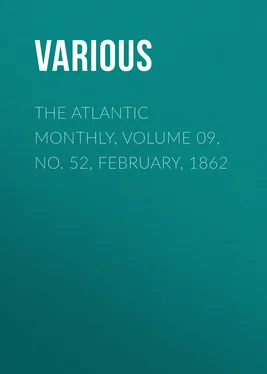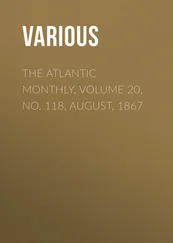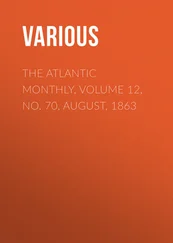Various - The Atlantic Monthly, Volume 09, No. 52, February, 1862
Здесь есть возможность читать онлайн «Various - The Atlantic Monthly, Volume 09, No. 52, February, 1862» — ознакомительный отрывок электронной книги совершенно бесплатно, а после прочтения отрывка купить полную версию. В некоторых случаях можно слушать аудио, скачать через торрент в формате fb2 и присутствует краткое содержание. Жанр: foreign_antique, periodic, foreign_edu, на английском языке. Описание произведения, (предисловие) а так же отзывы посетителей доступны на портале библиотеки ЛибКат.
- Название:The Atlantic Monthly, Volume 09, No. 52, February, 1862
- Автор:
- Жанр:
- Год:неизвестен
- ISBN:нет данных
- Рейтинг книги:5 / 5. Голосов: 1
-
Избранное:Добавить в избранное
- Отзывы:
-
Ваша оценка:
- 100
- 1
- 2
- 3
- 4
- 5
The Atlantic Monthly, Volume 09, No. 52, February, 1862: краткое содержание, описание и аннотация
Предлагаем к чтению аннотацию, описание, краткое содержание или предисловие (зависит от того, что написал сам автор книги «The Atlantic Monthly, Volume 09, No. 52, February, 1862»). Если вы не нашли необходимую информацию о книге — напишите в комментариях, мы постараемся отыскать её.
The Atlantic Monthly, Volume 09, No. 52, February, 1862 — читать онлайн ознакомительный отрывок
Ниже представлен текст книги, разбитый по страницам. Система сохранения места последней прочитанной страницы, позволяет с удобством читать онлайн бесплатно книгу «The Atlantic Monthly, Volume 09, No. 52, February, 1862», без необходимости каждый раз заново искать на чём Вы остановились. Поставьте закладку, и сможете в любой момент перейти на страницу, на которой закончили чтение.
Интервал:
Закладка:
Earnestness and the definite purpose which is its sign, love which drew the soul into sweetest communion with our mother Nature, giving to him who thus came revelations of the harmonies possible between her and her children, and devotion to his art mightier than ever inspired the Hindoo devotee in self-sacrifice, characterized those who have given all that pure Art which has been alluded to as the true: and such were the majority of those artists who preceded Raphael.
True, all of those who were devoted to Landscape Art, or who made it a part of their practice to introduce this element into their pictures, often failed in attaining truth; but, by some strange power with which they have invested their landscapes, an impulse is given to the perception, and the essential truth, feebly hinted at, perhaps, is recognized. But as the record comes down through the years, each new picture approximates more nearly to the character of the scene attempted, with, occasionally, (as in the works of Masaccio,) touches of truth absolutely perfect, until at last appeared that man altogether at one with Nature, who reproduced Nature in all its glory, pomp, freedom, and life, as might an archangel. Titian brought to perfection the first great class of Landscape Art, and, of course, in doing so, perfected that department which was the only one as yet developed, and which remains a distinct branch, subject to its own peculiar laws. We refer to the rendering of natural scenery, beginning in the merely and completely subordinate accessory, and ending, with Titian, in the perfectly dignified and noble companionship of the visible universe with man.
We speak of this Art perfected far back, because we feel assured that landscape, as accessory to the historical, has an ideal altogether distinct from that of pure landscape.
It would not be just, perhaps, to regard the law which necessitates this ideal as a law of subordination, although that condition prevails up to the time of Titian. Nature, to the true man, never presents itself as subordinate, but as correspondently ever equal with man, ever ready with possibilities to match his own. So true is this, that a man's universe, that of which his vision takes possession, is a part of himself, subject to his sorrows and joys, his hope and his despair: to him, the violets, the mountains, and the far-away worlds, throbbing in unison with his own heart-beat, are in some wise the signs or the manifestations of his own soul's possibilities. And he is right. That of the flower which is its beauty, that of the mountains which is their magnificent grandeur, that of the stars which is their ineffable glory and sublimity, is his, is within him, is a part of his soul's life, waxing or waning so in unison with its richness or poverty that wise men mark the soul's stature by the part of it which is akin to the violets, the hills, or the infinite sky.
"The world is as large as a man's head." In that there is a fine hint of a great truth, but beyond that is the truth. It is not the mere knowledge of Alcyone that necessitates the sublime. After that comes the wonder. The world is as large as is a man, and its relation to him is marked by a sympathy which acts and reacts with the certainty and precision of law.
The ideal of Landscape Art, used in alliance with representations of the human figure, must, then, be founded upon this immutable sympathy between the landscape world and the human. Thus, in the painting alluded to in the article on Mr. Page, "The Entombment" of the Louvre, the landscape is charged with the solemnity of the hour. No blade of grass or shadow of leaf but seems conscious of the great event, and the sky reveals, by its heavenly tenderness, that there all is known.
How different in expression, yet how similar in strength, is the landscape of that seeming miracle, "The Presentation in the Temple"! It is clear, confident day,—so pure and perfect a day abroad over the happy earth, that all things lure forth into an atmosphere so unsullied that to breathe it is life and joy,—over an earth youthful with spring, fresh with morning; and hither have come the people to see confirmed the future mother of Christ, now the child Mary. As the maiden ascends the steps of the Temple, a halo surrounds her,—not her head alone, but all the form,—and far away a fainter halo rests upon the hills. Her youth, its purity and half-recognized promise, seem sweetly imaged in the morning freshness and spring-life of the landscape.
We can remember no landscape by Titian which is not in full sympathy with the motives which actuate his groups. It is the unison of scene and act that gives his pictures a unity and completeness never or rarely found elsewhere.
After Titian came painters—among them, mighty ones—who, like Tintoretto, wrought from the external. The elements of the landscape were treated with knowledge and power, but not often with feeling, and very seldom with a recognition of its central significance. One example is so marvellous, however, that we cannot forbear referring to it. Its truthfulness is the more remarkable from the fact that the painter's conceptions rarely were such that any true landscape could be found capable of harmony with their character. In this picture, "The Temptation of Saint Anthony," one of the Pitti Palace Gallery, Salvator has wrought marvellously like a demon. The horizon and the sky near it are charged with a sense of demoniacal conflict for human souls, and forebodings of defeat and woe.
Yet within this, mantling the remotest depths, there is a sheen of light, a gleam of hope and faith.
In our own times there is little to refer to illustrative of excellence in this branch of Art. Overbeck makes frequent use of natural scenery, and his delicate yet firm outlines repeat, hill and valley and clouds, the sentiment of peace and purity which pervades his noble productions.
Not that there are not produced frequently, and especially in France, works remarkable for truth and power. But, too often, the truths are redundant, and the power vanquishes the sentiments of the group.
One artist in France, Rosa Bonheur, has, however, embodied conceptions so noble, so in unison with the finest Nature, that its most glorious and most significant scenery, rendered with a handling akin to the old mastership, is alone adequate to sympathize with and sustain them. I need but refer to the wonderful view of the Pyrenees in the picture of "The Muleteers," the tender morning spirit of that heathery scene in the Highlands, and that miracle of representation, the near ground, crisp and frosty, of Mr. Belmont's "Hunters in Early Morning."
American Art, as represented in Italy, has few examples of excellence in this branch of painting. Its followers have wrought more persistently in other directions, toward the expression of a class of ideals rarely involving the one which we have attempted to analyze. Yet, occasionally, an artist has appeared, making Rome or Florence his home long enough to win a place, which, when he has departed, is not quickly filled, who has ideas of history and events calling for the record of the palette; or there has been wrought in the studio of some resident painter a composition in which landscape has been employed as accessory.
In many instances there have been produced works which reflect the highest honor upon our country. As it is foreign to the purpose of the present paper to deal with other than the different phases of landscape-painting, we forbear to speak as their merits suggest of the figure portions of the works of Mr. Rothermel, the result of his brief sojourn in Italy. In any passage of scenery, and particularly in sky forms and tones, the expression and character are always such as support vigorously the action of his group. We say vigorously; for Mr. Rothermel, in his Italian pictures, revealed an artistic nature related to humanity in its most agitated moods, as in the "Lear," and in the "Saint Agnese,"—this beautiful picture being, however, a higher conception, inasmuch as in it the spirit might find some rest in the stillness of the maiden Agnese, already saint and about to be martyr, and in the deep blue sky, on whose field linger white clouds, like lambs "shepherded by the slow unwilling winds."
Читать дальшеИнтервал:
Закладка:
Похожие книги на «The Atlantic Monthly, Volume 09, No. 52, February, 1862»
Представляем Вашему вниманию похожие книги на «The Atlantic Monthly, Volume 09, No. 52, February, 1862» списком для выбора. Мы отобрали схожую по названию и смыслу литературу в надежде предоставить читателям больше вариантов отыскать новые, интересные, ещё непрочитанные произведения.
Обсуждение, отзывы о книге «The Atlantic Monthly, Volume 09, No. 52, February, 1862» и просто собственные мнения читателей. Оставьте ваши комментарии, напишите, что Вы думаете о произведении, его смысле или главных героях. Укажите что конкретно понравилось, а что нет, и почему Вы так считаете.












